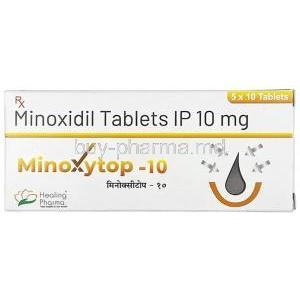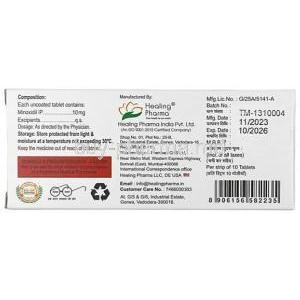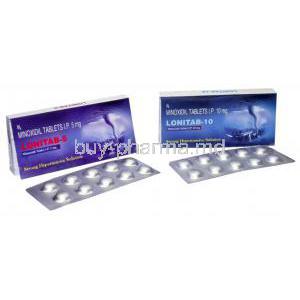Minoxidil
- I. Introduction
- II. Uses of Minoxidil
- III. Off-label Uses of Minoxidil
- IV. How Minoxidil Works
- V. Dosage and Administration
- VI. Composition of Minoxidil
- VII. Common Side Effects of Minoxidil
- VIII. Serious Side Effects and Warnings
- IX. Contraindications
- X. Careful Administration and Monitoring
- XI. Important Precautions
- XII. Interaction with Other Drugs
- XIII. Administration to Specific Populations
- XIV. Overdosage and Management
- XV. Storage Conditions and Handling Precautions
- XVI. Conclusion
I. Introduction
Historical Background of Minoxidil
Minoxidil has a story in the world of pharmacology. It was initially developed as a medication for blood pressure, but researchers soon discovered something unexpected. It helps with hair regrowth. This fortunate finding led to Minoxidil being used not for blood pressure control but also as a well-known treatment for hair loss, a condition known as alopecia.
FDA Approval and Indications
In the 1970s, the U.S. Food and Drug Administration (FDA) approved using Minoxidil to treat hypertension. By the 1980s, it also gained approval for treating androgenic alopecia when applied topically. It's worth mentioning that this is one of the treatments approved for female pattern hair loss. Minoxidil is available over the counter, making it easily accessible to those seeking its hair regrowth benefits.
General Overview and Purpose of the Drug
Minoxidil has two roles in the world of pharmaceuticals. When taken as a tablet, it widens blood vessels providing relief for those with blood pressure. When applied topically, it becomes a ray of hope for people dealing with receding hairlines and thinning hair.
II. Uses of Minoxidil
Treating Male and Female Pattern Baldness
Minoxidil’s fame stems from its ability to effectively combat alopecia, reversing the gradual progression of hair loss1. For men, it rejuvenates hair follicles, resulting in a decrease in balding at the top of the head2. Women, on the other hand, notice an increase in hair volume, particularly around the crown area3.
1: Minoxidil and Shedding: Why it Happens and What to Expect - Healthline 2: Oral Minoxidil for Hair Loss: Off-Label Use of the Drug, Explained - Health 3: Minoxidil: Dermatologists on What to Realistically Expect From the Hair …
Management of Hypertension
Before it became famous as a hair regrowth treatment, minoxidil was primarily used to improve hypertension. It works by causing blood vessels to widen, reducing the pressure on arteries and preventing problems12. Minoxidil belongs to the general class of medicines called antihypertensives2. It is usually prescribed by a specialist and taken long-term1.
1: Minoxidil for high blood pressure. Side-effects and dosage 2: Minoxidil (Oral Route) Description and Brand Names - Mayo Clinic
Other FDA Approved Indications
Although the primary uses of minoxidil are for promoting hair regrowth and controlling hypertension, the FDA has also approved its use for a few conditions. However, these additional applications are limited to patient groups. For example, oral minoxidil is supported by the FDA to treat high blood pressure in higher doses1. The FDA approves topical minoxidil to treat hair loss in men and women2. The FDA has not approved oral minoxidil for hair loss nor any other formulations of minoxidil, such as sprays or shampoos34.
1: Oral Minoxidil for Hair Loss: Off-Label Use of the Drug, Explained - Health 2: Minoxidil: What you need to know | Medical News Today 3: Minoxidil - Wikipedia 4: FDA Advisory No.2021-2347 - Food and Drug Administration
III. Off-label Uses of Minoxidil
Alopecia Areata Management
Alopecia areata, a condition where hair loss occurs in patches, has posed a challenge for dermatologists. While minoxidil is not officially approved for this use, it has been used with some degree of success, offering hope for those affected by the condition12. Minoxidil is a topical treatment that stimulates hair growth by increasing blood flow to the hair follicles2. It is more effective at higher concentrations (5% > 2%) and may be combined with other treatments for alopecia areata13. Some studies have also suggested that low-dose oral minoxidil may benefit some types of alopecia, including alopecia areata4.
1: Minoxidil en el tratamiento de la alopecia areata - Medigraphic 2: Hair loss - Diagnosis and treatment - Mayo Clinic 3: Minoxidil Use in Alopecia Areata: Useful or not? - Donovan Hair Clinic 4: Coming full circle (almost): Low dose oral minoxidil for alopecia
Beard and Eyebrow Enhancement
A growing trend among people is to use minoxidil to improve the thickness of hair and eyebrows. Many individuals who want to add fullness to their sparse beards or eyebrows have started using this product, and there are some personal stories suggesting that it may be effective12. However, minoxidil is not designed for use on the eyebrows or the beard, and it has not been clinically tested enough to be considered safe for these purposes13. Minoxidil is a drug that has only been FDA-approved for usage on the scalp to treat hair loss3. Using minoxidil on other body parts may cause unwanted side effects, such as skin irritation, itching, redness, or unwanted hair growth in other areas45. Therefore, using minoxidil for eyebrows or beard growth is not recommended without consulting a doctor first.
1: Can I use Rogaine for eyebrow growth? - Minoxidil beard growth 2: Does Minoxidil work on eyebrows? - Blog - Wimpole 3: Minoxidil for Beard and Facial Health Growth: Can Rogaine Help? 4: Using minoxidil on eyebrows? : r/Minoxbeards - Reddit 5: Rogaine for Eyebrows: Does It Work? Plus How to Use - Healthline
Treatment of Chemotherapy-Induced Alopecia
Chemotherapy can be an experience, especially when it leads to hair loss. To help alleviate this side effect, some oncologists suggest using minoxidil. This approach aims to improve the emotional impact of losing hair and the speed of hair regrowth after chemotherapy12. Minoxidil is a drug that stimulates hair growth by increasing blood flow to the hair follicles1. However, minoxidil is not likely to prevent hair loss during chemotherapy, and its effectiveness may vary depending on the type and dose of chemotherapy drugs used13. Minoxidil can be applied topically or taken orally, depending on the severity of hair loss and the preference of the patient4. Minoxidil may have some side effects, such as skin irritation, itching, or unwanted hair growth on other parts of the body1. Therefore, it is essential to consult a doctor before using minoxidil for chemotherapy-induced hair loss.
1: Chemotherapy and hair loss: What to expect during treatment 2: Chemotherapy and Hair Loss: Why they are related? - Minoxidil Spray 3: Hair growth after chemo: When does hair grow back? - Medical News Today 4: Alopecia related to systemic cancer therapy - UpToDate
IV. How Minoxidil Works
Mechanism of Action in Hair Regrowth
The way minoxidil works to promote hair regrowth is still not fully understood. Some theories propose that it rejuvenates hair follicles, extends the growth phase of hair (known as the anagen phase), and increases the size of the dermal papilla, which helps produce strong hair strands.
Vasodilatory Effects and Blood Pressure Control
Minoxidil is a vasodilator in the field of hypertension. It works by opening up potassium channels in the muscle cells of blood vessels resulting in a decrease in calcium within the cells. This relaxation effect ultimately leads to a reduction in blood pressure.
Cellular and Molecular Pathways Activated
The precise coordination of cells that leads to the effects of Minoxidil is complex. Initial studies indicate that it may involve molecular pathways, such as the promotion of prostaglandin E2 production and the stimulation of adenosine receptors.
V. Dosage and Administration
Standard Dosing Guidelines
A typical Minoxidil treatment plan consists of two parts; 1. Taking the medication orally; It is usually recommended to take 10 40mg per day divided into two doses to manage hypertension. 2. Applying the solution topically; To promote hair regrowth, it is advised to apply 1ml of either the 2% or 5% solution twice a day.
Adjustments for Specific Populations
Dosage adjustments may be required for patients, children, and individuals with kidney problems. Healthcare professionals usually gradually increase the medication dosage while closely monitoring how each patient responds to it.
Routes of Administration: Oral vs. Topical
The oral method is used to address hypertension, while the topical option is designed to promote hair regrowth. The choice between these two approaches depends on the treatment goal. It is ultimately determined by physicians who consider the patient's clinical condition as the deciding factor.
VI. Composition of Minoxidil
Active Ingredient Analysis
Minoxidil's effectiveness stems from its structure, the piperidine pyrimidine derivative. This particular component gives the medication its characteristics distinguishing it from other hypertension and hair regrowth treatments.

Inactive Components and Their Roles
Apart from the ingredient, Minoxidil solutions commonly include several additional substances, Alcohol, which Helps with penetration and quick drying. Propylene glycol; Improves solubility and texture. Purified water; Acts as a solvent. Even though these components are not active, they play a role in the effectiveness of the medication and how users perceive it.
Variations Between Brand and Generic Forms
Although the main component remains, the slight differences in the inactive ingredients between brand name and generic versions could potentially affect the physical characteristics and smell of the drug. However, overall effectiveness is generally unaffected in both versions.
VII. Common Side Effects of Minoxidil
Skin Irritation and Sensitivity
Sometimes when you use Minoxidil, it can cause skin irritation. You might experience redness, flaking, and a stinging feeling. Usually, these effects are temporary. However, if the offense becomes severe it's best to stop using it and seek advice, from a healthcare professional. To alleviate scalp sensitivity using a shampoo that is hypoallergenic may be helpful.
Systemic Effects: Hypotension, Tachycardia
Although Minoxidil is primarily intended for application, it can also affect the body as a whole. The most significant effects are blood pressure (hypotension) and increased heart rate (tachycardia). These reactions occur because the drug has properties that widen blood vessels, initially intended to manage hypertension.
Psychological Effects: Anxiety and Depression
Another aspect to consider, although not widely discussed, is the possibility of Minoxidil having impacts, such as feelings of anxiety and depression. It's still uncertain whether these effects result from the medication or a response to changes in one's physical appearance.
VIII. Serious Side Effects and Warnings
Risk of Severe Hypotension
Since Minoxidil was initially developed as a medication to treat blood pressure, it can cause significant drops in blood pressure, particularly when taken orally. Healthcare professionals must remain cautious and ensure patients are well-informed about this risk.
Potential for Unwanted Facial/Body Hair Growth
Minoxidil presents an effect where it can stimulate hair growth in areas that are not desired, such, as the face and body, particularly in women. To mitigate this risk, patients must apply the solution exclusively to the scalp.
Dermatologic Reactions: Allergic Contact Dermatitis
Sometimes Minoxidil can cause a reaction called allergic contact dermatitis. This reaction is characterized by redness, itching, and skin blistering. Doing a patch test before applying it thoroughly might be an idea to determine if you are susceptible to it.
IX. Contraindications
Absolute and Relative Contraindications
Minoxidil should not be used in patients who have had an allergic reaction to the medication or any of its ingredients. People with cardiovascular diseases should also be cautious about using Minoxidil as it may worsen these conditions.
Pediatric and Geriatric Populations
Minoxidil is typically administered with care when it comes to pediatric and geriatric populations. This is because these age groups have ways of processing the drug and are more susceptible to potential systemic effects.
Pregnancy and Nursing Considerations
Minoxidil falls under category C for pregnancy drugs suggesting a risk to the unborn baby. It is also advisable for breastfeeding moms to refrain from using Minoxidil as it may be excreted in breast milk. Potentially affect the baby.
X. Careful Administration and Monitoring
Regular Blood Pressure Checks
Patients using Minoxidil in oral forms should undergo regular blood pressure assessments to keep track of any instances of low blood pressure and ensure timely adjustments to the dosage if needed.
Skin Examination and Care
It is essential to examine your skin to catch any early indications of dermatological reactions. Taking care of your skin, such, as moisturizing it, can help reduce the irritating effects caused by the medication.
Monitoring for Systemic Effects
When it comes to using Minoxidil, doctors should take a proactive approach in keeping an eye out for any potential side effects, such as fluid retention and heart palpitations.
XI. Important Precautions
Avoidance of Alcohol and Irritant Products
To minimize skin irritation when using Minoxidil, it is recommended that patients refrain from using skincare products that contain alcohol or any other irritants.
Sun Protection Measures
When using Minoxidil, it is recommended to take measures to protect your scalp from the sun. This includes using broad-spectrum sunscreens and wearing hats or other physical barriers to shield the scalp.
What to Do in Case of Missed Dose
If a dose is missed, patients should apply Minoxidil soon as they remember but they should not take two doses at once to make up for the forgotten application.
XII. Interaction with Other Drugs
Potential for Synergism or Antagonism
Minoxidil has the potential to interact with medications used for managing high blood pressure. These interactions can. Enhance or reduce its ability to lower blood pressure. Healthcare professionals must be aware of these interactions while creating a treatment strategy.

Drugs that Increase Risks of Side Effects
Some medications, like beta blockers, can cause the side effects of Minoxidil. These side effects may include a heart rate and low blood pressure.
Common Over-the-Counter Interactions
Over-the-counter products, like creams containing corticosteroids, have the potential to interact with Minoxidil. It may increase the level of skin irritation.
XIII. Administration to Specific Populations
Administration to Elderly: Risks and Considerations
In patients, it is recommended to start Minoxidil at a lower dosage to assess their response and reduce potential side effects. Regular monitoring is crucial because this population tends to have other health conditions.
Administration to Pregnant Women and Nursing Mothers: Safety Profile
Due to the lack of information regarding the safety of using Minoxidil during pregnancy and breastfeeding, it is usually recommended to avoid its use in these situations. Instead, it is generally advisable to consider treatments with a well-documented safety history.
Administration to Children: Efficacy and Safety Concerns
It is generally not advised to use Minoxidil in children because information is available regarding its safety and effectiveness in this age group.
XIV. Overdosage and Management
Signs and Symptoms of Overdose
Symptoms of taking Minoxidil can involve severe low blood pressure, rapid heartbeat, and fluid buildup. Additionally, if you notice a fast or prominent growth of hair, it could suggest excessive application of topical Minoxidil.
Immediate Steps for Overdose Management
If someone experiences an overdose, it is crucial to seek medical help. The treatment primarily involves providing care, such as administering fluids to address low blood pressure and replenishing electrolytes if needed.
Long-term Health Implications
Taking doses for an extended period could have severe consequences for your health, such as permanent damage, to your heart or kidneys. Therefore it is crucial to follow the prescribed dosage.
XV. Storage Conditions and Handling Precautions
Optimal Storage Temperatures and Conditions
Minoxidil should be stored in a place with a controlled room temperature where it is protected from moisture and heat. It's essential to avoid exposing it to temperatures as this may affect the quality of the solution.
Safeguarding Against Accidental Ingestion
To ensure safety for children and pets, it is essential to securely seal and store containers of Minoxidil, in a location that is not easily reachable.
Proper Disposal of Unused or Expired Minoxidil
You should not throw away Minoxidil that has expired or is no longer needed by flushing it down the toilet or throwing it in the trash. It's best to consult with a pharmacist or a local waste disposal company to find safe ways to dispose of it.
XVI. Conclusion
Summary of Minoxidil’s Efficacy and Safety
Minoxidil has proven to be a vasodilator that effectively promotes hair regrowth. Although it is generally safe when applied topically to treat alopecia, it's essential to note that there are potential side effects and systemic considerations associated with its use.
Alternative Treatments and Comparisons
There are options available apart from Minoxidil, such, as Finasteride, which is a systemic DHT inhibitor, and low-level laser therapy (LLLT), which involves using red light to stimulate hair follicles. Each of these alternatives has its set of risks and benefits that patients should discuss with their healthcare provider.
Future Directions in Minoxidil Research and Use
New studies are investigating ways to use Minoxidil, such as different formulations and combinations, with other treatments to see how it can help different types of hair loss. As we learn more, we might discover uses and better understand the safety of Minoxidil.

























